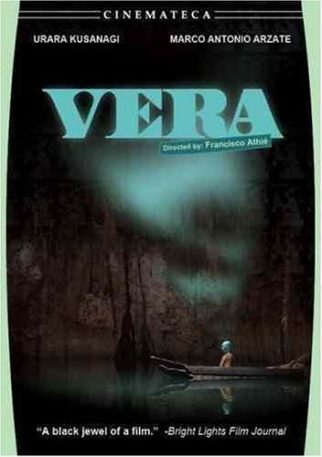 This “transcendental journey of the soul” mixes Mayan mysticism with CGI and elegantly lensed live action into a head-scratching whole that must be counted as one of the most profoundly bizarre Mexican films since the heyday of Alejandro Jodorowsky.
This “transcendental journey of the soul” mixes Mayan mysticism with CGI and elegantly lensed live action into a head-scratching whole that must be counted as one of the most profoundly bizarre Mexican films since the heyday of Alejandro Jodorowsky.
This 2002 film was a deeply felt labor of love by filmmaker Francisco Athie, whose other features, which include LOLO (1993), FIBRA OPTICA (1998) and EL BAILE DE SAN JUAN (2010), won’t prepare you for the overpowering weirdness of VERA.
You also probably won’t be prepared for the poor 2006 DVD transfer from Facets Video, who can always be counted on for substandard DVD treatment, and more than uphold that tradition here.
The elderly miner Juan is injured by an underground cave-in. Making his way into what he thinks is daylight, Juan becomes enmeshed in a weird subconscious realm where a ghostly wind knocks him unconscious. He comes to outside a shack, inside of which are pieces of fruit that turn to dust in Juan’s hands. There’s also a picture frame that plays back scenes from Juan’s past.
Next Juan finds himself back in the cave. Here a trickle of water quenches his thirst, but that trickle quickly becomes a flood that washes him into yet another hallucinatory realm.
Here Juan is faced with a pot of some boiling substance, the sight of which moves him to recall his Mayan heritage and pray. He also slices up his penis, the blood of which drips into the contents of the pot. This leads to a further flood of psychedelic visions, which culminate in the birth of an alien woman from a slimy amniotic sac.
Said alien is a spindly green creature with an open cavity where her heart should be that when peered into shows Juan an image of himself trapped in the cave. Juan and the alien gal, it transpires, have a psychic connection. She imparts visions and in the process grows increasingly human. She also dances with a tiny human skeleton that she eventually tires of and smashes on a rock.
Juan and the woman wind up sailing down an underground stream in a rowboat. Their final destination is an idyllic garden where the woman performs an act familiar from quite a few creation myths.
For all the hallucinatory weirdness on display, Francisco Athie’s direction is resolutely straightforward and unshowy. This means the spastic camerawork, fisheye lenses and freaky ambiance you might expect from a psychedelic spectacle like this one are nowhere to be found. Measured pacing and silence—the music is muted and the dialogue extremely sparse—are Athie’s most noteworthy cinematic quirks, and only serve to enhance the weirdness.
That’s particularly true of Athie’s use of digital animation. The CGI isn’t quite as “seamlessly integrated” as the DVD notes claim, but it is utilized in a strikingly unobtrusive manner that Hollywood filmmakers would do well to study. Standout moments include the protagonist’s early encounter with the alien woman and the latter’s climactic dance with a CGI skeleton.
As for the film overall, it is truly (as was said of EL TOPO) “beyond criticism.” This is to say that it exists in a universe of its own and is very much of a piece, hence there’s no point in looking for “flaws,” much less a comprehensive understanding of the its multitude of Mayan-based religious imagery. VERA is a film you’ll either respond to or you won’t. It is what it is.
Vital Statistics
VERA
Imcine/Arroba Films
Director: Francisco Athie
Producer: Rafael Cuervo
Screenplay: Francisco Athie
Cinematography: Ramon F. Suarez
Editing: Samuel Larson
Cast: Urara Kusanagi, Marco Antonio Arzate, Lorena Caballero, Don Candido Balam
